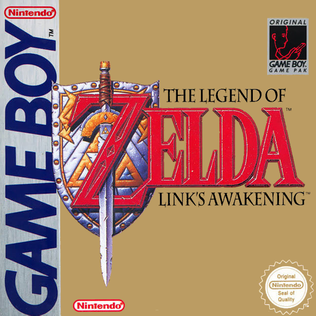 W
WThe Legend of Zelda, originally released in Japan as The Hyrule Fantasy: Zelda no Densetsu, is a 1986 action-adventure video game developed and published by Nintendo and designed by Shigeru Miyamoto and Takashi Tezuka. Set in the fantasy land of Hyrule, the plot centers on an elf-like boy named Link, who aims to collect the eight fragments of the Triforce of Wisdom in order to rescue Princess Zelda from the antagonist, Ganon. During the course of the game, the player controls Link from a top-down perspective and navigates throughout the overworld and dungeons, collecting weapons, defeating enemies and uncovering secrets along the way.
 W
WThe Legend of Zelda: A Link to the Past is an action-adventure game developed and published by Nintendo for the Super Nintendo Entertainment System. It is the third game in The Legend of Zelda series and was released in 1991 in Japan and 1992 in North America and Europe.
 W
WThe Legend of Zelda: Link's Awakening is a 1993 action-adventure game developed and published by Nintendo for the Game Boy. It is the fourth installment in the Legend of Zelda series and the first for a handheld game console. Link's Awakening is one of the few Zelda games not to take place in the land of Hyrule, and it does not feature Princess Zelda or the Triforce relic. Instead, the protagonist Link begins the game stranded on Koholint Island, a place guarded by a whale-like deity called the Wind Fish. Assuming the role of Link, the player fights monsters and solves puzzles while searching for eight musical instruments that will awaken the sleeping Wind Fish and allow him to escape from the island.
 W
WSuper Mario 64 is a 1996 platform game for the Nintendo 64 and the first Super Mario game to feature 3D gameplay. It was developed by Nintendo EAD and published by Nintendo. Super Mario 64 features 3-dimensional freedom of movement within a large open world based on 3D polygons. It builds upon the Mario tradition of gameplay elements, visual style, and characters. As Mario, the player explores Princess Peach's castle to rescue her from Bowser.
 W
WSuper Mario All-Stars is a 1993 compilation of platform games for the Super Nintendo Entertainment System (SNES). It contains remakes of Nintendo's four Super Mario games released for the Nintendo Entertainment System (NES) and the Famicom Disk System: Super Mario Bros. (1985), Super Mario Bros.: The Lost Levels (1986), Super Mario Bros. 2 (1988), and Super Mario Bros. 3 (1988). As in the original games, players control the Italian plumber Mario and his brother Luigi through themed worlds, collecting power-ups, avoiding obstacles, and finding secret areas. The remakes feature updated graphics—including the addition of parallax scrolling—and music, modified game physics, and bug fixes.
 W
WSuper Mario Bros. 3 is a platform game developed and published by Nintendo for the Nintendo Entertainment System (NES). It was released for home consoles in Japan on October 23, 1988, in North America on February 12, 1990 and in Europe on August 29, 1991. Prior to its release on the NES, it was initially released in North America on July 15, 1989 via PlayChoice-10 arcade machines. It was developed by Nintendo Entertainment Analysis and Development, led by Shigeru Miyamoto and Takashi Tezuka.
 W
WSuper Mario Bros.: The Lost Levels is a 1986 platform game developed and published by Nintendo as the sequel to Super Mario Bros. (1985). The games are similar in style and gameplay, with players controlling Mario or Luigi to rescue the Princess from Bowser. The Lost Levels adds a greater level of difficulty and Luigi controls slightly differently from Mario, with reduced ground friction and increased jump height. The Lost Levels also introduces obstacles such as poison mushroom power-ups, counterproductive level warps, and mid-air wind gusts. The game has 32 levels across eight worlds and 20 bonus levels.
 W
WSuper Mario Run is a 2016 platform video game developed and published by Nintendo for iOS and later Android. It is Nintendo's first mobile game that is part of one of the company's long-running and major franchises.
 W
WSuper Mario World is a 1990 platform game developed by Nintendo for the Super Nintendo Entertainment System (SNES). The story follows Mario's quest to save Princess Toadstool and Dinosaur Land from the series' antagonist Bowser and his minions, the Koopalings. The gameplay is similar to that of earlier Super Mario games: players control Mario or his brother Luigi through a series of levels in which the goal is to reach the goalpost at the end. Super Mario World introduced Yoshi, a dinosaur who can eat enemies, as well as gain abilities by eating the shells of Koopa Troopas.
 W
WSuper Mario World 2: Yoshi's Island is a 1995 platform game developed and published by Nintendo for the Super Nintendo Entertainment System (SNES). To reunite baby Mario with his brother Luigi, who has been kidnapped by Kamek, the player controls Yoshi, a friendly dinosaur, through 48 levels while carrying Baby Mario. As a Super Mario series platformer, Yoshi runs and jumps to reach the end of the level while solving puzzles and collecting items. In a style new to the series, the game has a hand-drawn aesthetic and is the first to have Yoshi as its main character. The game introduces his signature abilities to flutter jump and produce eggs from swallowed enemies.